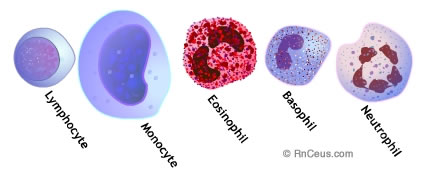

Neutrophils
Neutrophils are so named because they are not well stained by either eosin, a red acidic stain, nor by methylene blue, a basic or alkaline stain. Neutrophils, are also known as "segs", "PMNs" or "polys" (polymorphonuclears). They are the body's primary defense against bacterial infection and physiologic stress. Normally, most of the neutrophils circulating in the bloodstream are in a mature form, with the nucleus of the cell being divided or segmented. Because of the segmented appearance of the nucleus, neutrophils are sometimes referred to as "segs." The nucleus of less mature neutrophils is not segmented, but has a band or rod-like shape. Less mature neutrophils - those that have recently been released from the bone marrow into the bloodstream - are known as "bands" or "stabs". Stab is a German term for rod.
Increased neutrophil count
An increased need for neutrophils, as with an acute bacterial infection, will cause an increase in both the total number of mature neutrophils and the less mature bands or stabs to respond to the infection. The term "shift to the left" is often used when determining if a patient has an inflammatory process such as acute appendicitis or cholecystitis. This term is a holdover from days in which lab reports were written by hand. Bands or stabs, the less mature neutrophil forms, were written first on the left-hand side of the laboratory report. Today, the term "shift to the left" means that the bands or stabs have increased, indicating an infection in progress.
For example, a patient with acute appendicitis might have a "WBC count of 15,000 with 65% of the cells being mature neutrophils and an increase in stabs or band cells to 10%". This report is typical of a "shift to the left", and will be taken into consideration along with history and physical findings, to determine how the patient's appendicitis will be treated.
Instant Feedback:
In addition to bacterial infections, neutrophil counts are increased in many inflammatory processes, during physical stress, or with tissue necrosis that might occur after a severe burn or a myocardial infarction. Neutrophils are also increased in granulocytic leukemia.
Decreased neutrophil count
A decrease in neutrophils is known as neutropenia. Although most bacterial infections stimulate an increase in neutrophils, some bacterial infections such as typhoid fever and brucelosis and many viral diseases, including hepatitis, influenza, rubella, rubeola, and mumps, decrease the neutrophil count. An overwhelming infection can also deplete the bone marrow of neutrophils and produce neutropenia. Many antineoplastic drugs used to treat cancer produce bone marrow depression and can significantly lower the neutrophil count. Types of drugs that can produce neutropenia include some antibiotics, the psychotropic drug lithium, phenothiazines, and tricyclic antidepressants.
Instant Feedback:
Eosinophils
Eosinophils are associated with antigen-antibody reactions. The most common reasons for an increase in the eosinophil count are allergic reactions such as hay fever, asthma, or drug hypersensitivity. Decreases in the eosinophil count may be seen when a patient is receiving corticosteroid drugs.
Basophils
The purpose of basophils is not completely understood. Basophils are phagocytes and contain heparin, histamines, and serotonin. Tissue basophils are also called"mast cells." Similar to blood basophils, they produce and store heparin, histamine, and serotonin. Basophil counts are used to analyze allergic reactions. An alteration in bone marrow function such as leukemia or Hodgkin's disease may cause an increase in basophils. Corticosteroid drugs, allergic reactions, and acute infections may cause the body's small basophil numbers to decrease.
Lymphocytes
Lymphocytes are the primary components of the body's immune system. They are the source of serum immunoglobulins and of cellular immune response. As a result, they play an important role in immunologic reactions. All lymphocytes are produced in the bone marrow. The B-cell lymphocyte also matures in the bone marrow; the T-cell lymphocyte matures in the thymus gland. The B cells control the antigen-antibody response that is specific to an offending antigen. The T cells are the master immune cells of the body, consisting of T-4 helper cells, killer cells, cytotoxic cells, and suppressor T-8 cells. The majority of lymphocytes that circulate in the blood are T-lymphocytes, rather than B-lymphocytes. To help diagnose immune system deficiencies such as AIDS, the lab does specialized tests of T-lymphocytes. In the WBC, T and B-lymphocytes are reported together. In adults, lymphocytes are the second most common WBC type after neutrophils. In young children under age 8, lymphocytes are more common than neutrophils.
Lymphocytes increase in many viral infections and with tuberculosis. A common reason for significant lymphocytosis is lymphocytic leukemia. The majority of both acute and chronic forms of leukemia affect lymphocytes.
Due to research on HIV infection, a virus that affects T-lymphocytes, much more is now known about lymphocytes and their functions. HIV causes a reduction in the total number of lymphocytes as well as changes in the ratios of the types of T-lymphocytes. Corticosteroids and other immunosuppressive drugs also cause lymphopenia. A decreased lymphocyte count of less than 500 places a patient at very high risk of infection, particularly viral infections. It is important when the lymphocyte count is low to implement measures to protect the patient from infection.
Instant Feedback:
Monocytes
Monocytes are the largest cells in normal blood. They act as phagocytes in some inflammatory diseases and are the body's second line of defense against infection. Phagocytic monocytes produce the antiviral substance interferon. Diseases that cause a monocytosis include tuberculosis, malaria, Rocky Mountain spotted fever, monocytic leukemia, chronic ulcerative colitis and regional enteritis
The Body.com is an enormous resource about HIV infection. Visit this link for insight into how the CBC is interpreted in light of HIV infection.
© RnCeus.com